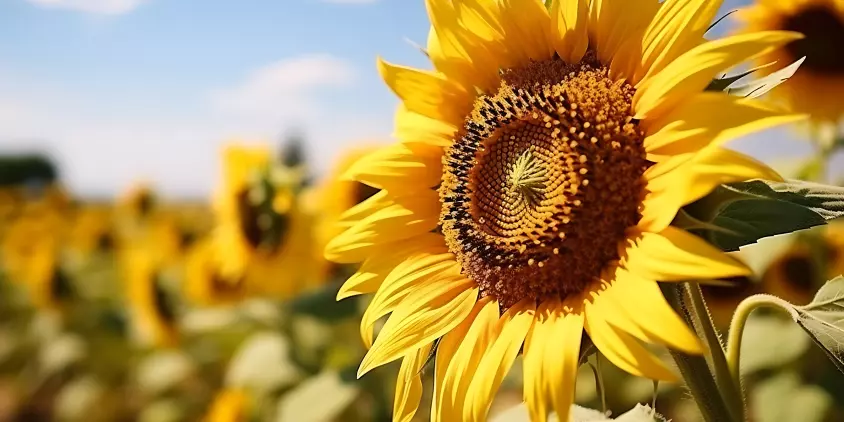
Growing Sunflowers: High-Yield Cultivation Practices
Sunflowers are a lucrative crop for farmers with their multiple uses, from edible oil and seeds to feed for livestock. Success in growing sunflowers starts with understanding local growing conditions and planting at the right time. For successful sunflower cultivation, farmers have to keep an eye on their crops all season long, making sure that the growing plants have sufficient water, fertile soil, and are free of pests. Last but not least, timely harvesting is essential so that neither money nor seeds are wasted due to wrong harvest scheduling. By drawing on agronomic expertise and modern agricultural technologies, farmers can overcome difficulties and promote sunflower farming to its full potential.
Optimal Growing Conditions For Sunflowers
These plants are well-known for their humble nature and simple cultivation. With the right growing conditions, which we’ll go into next, you can successfully cultivate this cash crop.
Where Do Sunflowers Grow?
The sunflower (Helianthus annuus) is native to North and Central America. This annual plant grows well in dry, open places like meadows, prairies, and plains. Forest-steppe and steppe zones, except for the southern part of the steppe, provide the ideal environment for growing sunflowers. Commercial growing takes place in warm temperate areas, although breeding and selection have resulted in cultivars that are adaptable to a wide range of climates.
USDA plant hardiness zones 4 through 9 are the most suitable for growing them.
Sunlight
The plant’s name is spot-on, given that sunflowers do need full sun to grow well. For maximum flowering and stalk strength, they require long-lit days (at least six hours of exposure to sunlight). This plant is heliotropic, so it will grow straighter if given enough time in the direct sun, rather than having to lean in the direction of most of the sun’s rays.
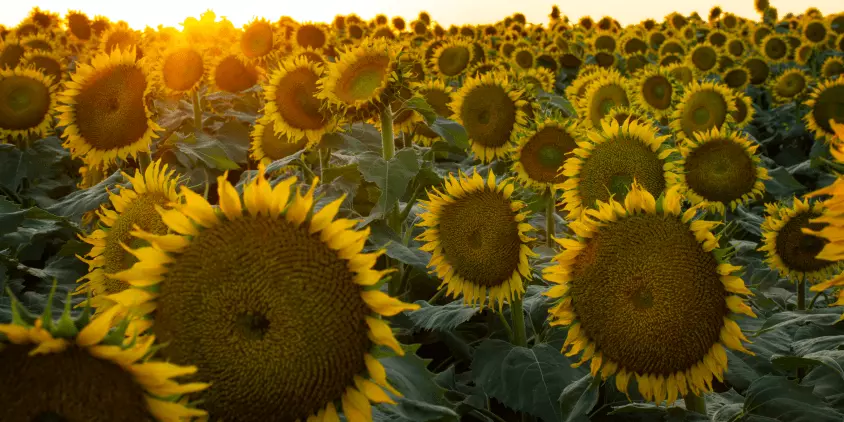
Temperature
An ideal sunflower growing temperature range is 70–78°F (21–26°C). If the plants are given enough water, they can endure much higher temperatures without heat stress. They may also grow in cool but sunny climates, but they can’t survive exposure to temperatures of 26 to 23°F (-3 to -5°C) for about 6 hours.
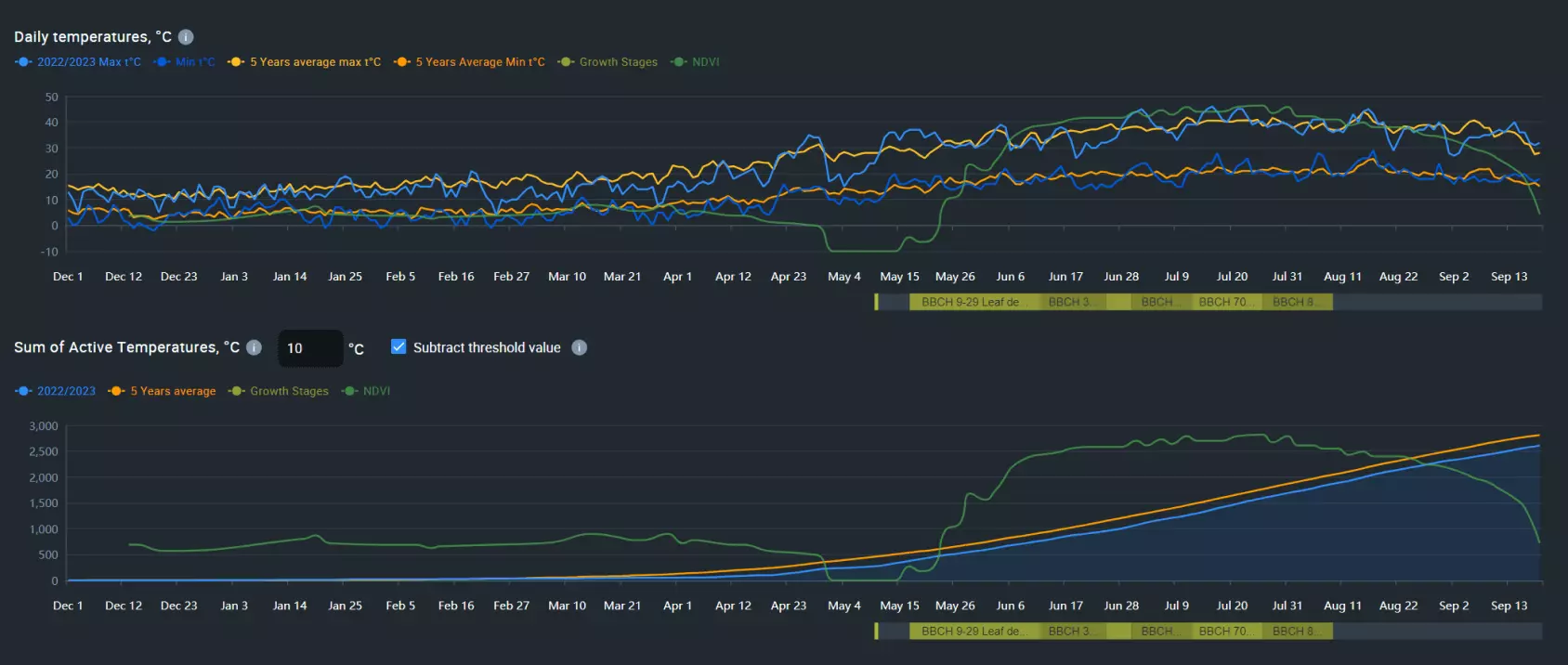
Choosing a field with the proper sunlight and temperature regime is vital for growing a healthy crop. With the help of EOSDA Crop Monitoring, farmers can promptly assess the potential of a specific field or region, for example, by accessing daily temperature data and the sum of active temperatures from the past.
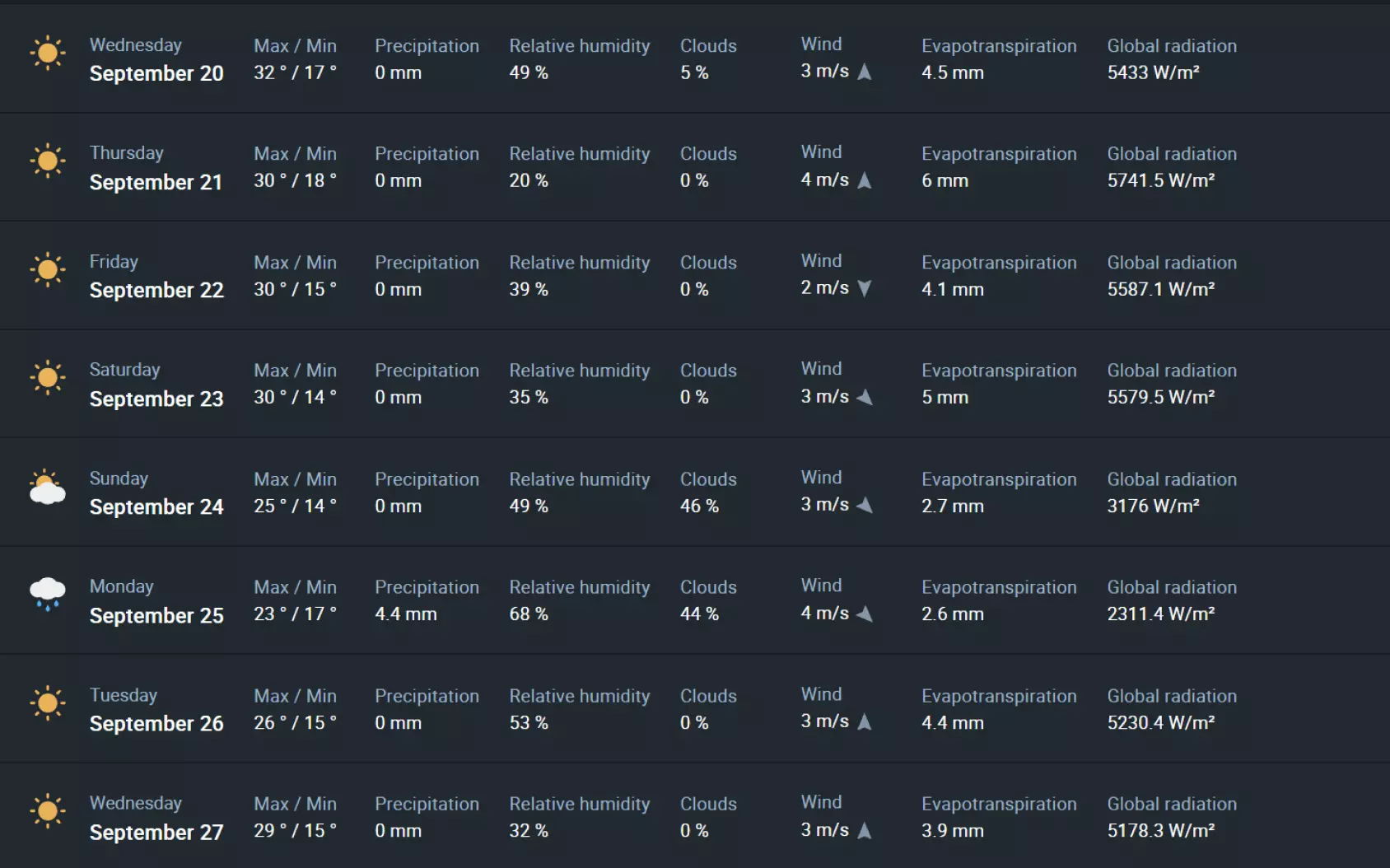
Soil
The plants can grow in a wide range of soil types but produce their maximum yields on neutral soils with a pH between 6.5 and 7.5 and adequate drainage. If your soil pH is below 5.5, adding lime will make it more suitable for growing these plants. The best soil for sunflowers is sandy loam, but clay loam or silty clay can do in a pinch.
Water
Hybrid, plant population, climate, and soil type are only a few of the variables that influence how much water a growing crop requires. Although the average water need is between 20 and 26 inches (500 and 670 mm) of water during the growing season, sunflowers also grow in arid environments thanks to their ability to draw water from a depth of up to 5 feet (1.5 meters).
The time between flowering and seed filling is the most critical in terms of avoiding drought stress. A shortage of water during this period may reduce both the quantity and the quality of the seed oil produced.
Sunflower Crop Planting And Cultivation
While deciding on the timing of the sunflower planting season, it is important to take into account the plant’s germination temperature requirements as well as the precise sunflower hybrid’s maturity time. Though not picky plants, they do need regular watering and nutrient-rich soil during the growing season.
When Are Sunflowers In Season?
They usually start making their way from newly planted seeds to mature plants sometime between March and May, depending on the variety and growing conditions in the field. Plants germinate at the end of spring and bloom for a total of 30–45 days in the summer through fall (typically peaking around midsummer). When the first frosts of fall arrive, plants perish and sunflower season ends.
How Long Do Sunflowers Take To Grow?
The sunflower’s growth time averages between 80 and 120 days. When it comes to non-branching varieties, the days-to-maturity number listed on seed packs is usually a reliable estimate of when the plants will be in full bloom and suitable for harvesting. If you want your plants to have enough time to grow in your climate, you’ll need to account for this number when planning your sowing activities.
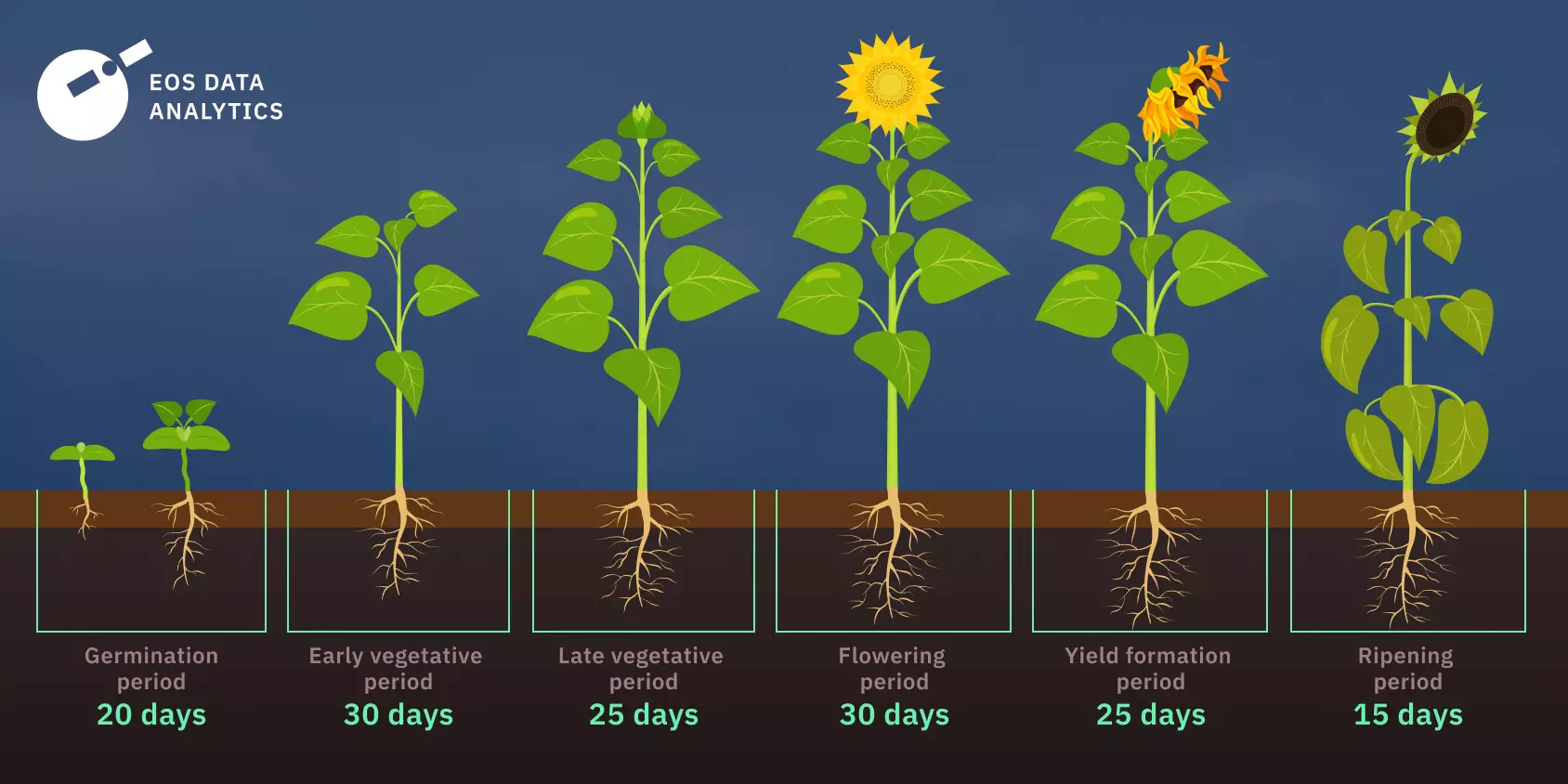
Sowing Sunflower Seeds
The best time to sow sunflower seeds is once the frost risk has passed and the soil temperature is at least 50°F (10°C). Too cold soil may put them in a dormant state, delaying germination. To ensure healthy and uniform germination, also take care of the proper planting depth. How deep to plant sunflower seeds? The standard recommendation is 1 to 2 inches (2.5 to 5 cm); sunflower planting depths over 3 inches (7.6 cm) are strongly discouraged.
Sunflower spacing should be consistent: around 6 and 12 inches (15 and 30 cm) for shorter and taller cultivars, respectively. Provide at least 2 feet (60 cm) of distance between the rows. After 10–12 days, pull out any extra seedlings so there is a spacing of 8 inches (20 cm) between flowers in a row.
After planting, cover the ground with 3 to 4 inches (8–10 cm) of mulch. At this time, when young, growing plants are most vulnerable to water loss and weed development, this measure will prove invaluable.
Irrigation
Consistent watering after planting a seed is essential for successful germination. As a general guideline, the soil should be moist but not soaked. Once a plant is established, even if rainfall alone is sufficient, water stress and yield loss may still occur due to fluctuations in water availability throughout the various stages of a growing season.
Oil-type sunflowers that are growing in irrigated soil produce an extra 92 kilograms of seeds per hectare, on average, compared to their dryland counterparts . However, farmers often mistakenly believe that more water always translates into higher yield, opting for flood or basin irrigation despite the growing risks of lodging and root rot. Precision irrigation through sprinklers or drip watering reduces these risks while maximizing seed and oil production.
Fertilizing
A nitrogen (N) deficit can limit crop yields. Still, finding the right N-rate for your area is critical, as too much nitrogen will diminish oil concentration in seeds, lowering crop quality. The potassium (K) needs of the growing plant are likewise rather high. When sunflowers are growing in arid climates where chloride may accumulate, potassium sulfate (SOP) is widely recommended. Sunflower is an excellent crop to include in a rotation because its deep root system may absorb nitrogen and other nutrients that would otherwise seep below crops with shallow roots.
EOSDA Crop Monitoring
Offering high-resolution satellite images for fields analytics to monitor crops health remotely!
Preventing And Treating Weeds, Diseases, And Pests In Sunflowers
Although these plants are prone to many weeds, pests, and diseases, any form of control is rarely necessary. Nonetheless, farmers have to carefully examine this issue because the risks may differ from region to region and from season to season.
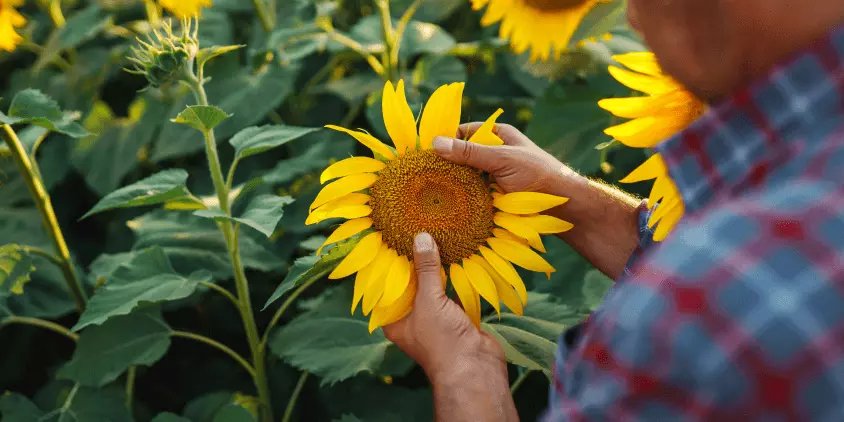
Weed Control
The crop has a tough time keeping up with weeds at the beginning of the growing season. It has been reported that yield drops by 60–90% when dealing with heavy weed pressure . Crops might even fail in the growing presence of such noxious weeds as kochia, horseweed, lambsquarter, and redroot pigweed. Weeds growing in sunflower fields can be managed with a combination of chemical treatments and cultural practices. Crop rotation and planting at the right time are two of the most important cultural practices for integrated weed management when growing sunflowers.
Disease Control
A small number of pathogens like nematodes, viruses, bacteria, and fungi cause the industry to lose millions of dollars each year. Fungi are the root cause of most problems in commercial sunflower growing. Some common examples of these fungi include black rust, downy mildew, Phomopsis stem canker, gray mold, and white mold. Prevention (through crop rotation, for example), escape (by adjusting planting dates), and the creation of microclimates unfavorable to diseases (via management of vegetative growth) are three pillars of disease control .
To effectively implement these strategies, you first need to determine the specific threats to your sunflower fields. The problem is that it is not so easy to recognize the disease at an early stage by eye. Nevertheless, this can be done with the specialized crop monitoring system for an agricultural field. By analyzing the growth stage and the weather forecast for up to 14 days, our advanced Disease risk modeling shows which of the common sunflower diseases might strike your field soon. This information allows you to spring into action and mitigate risks before they impact your yield.
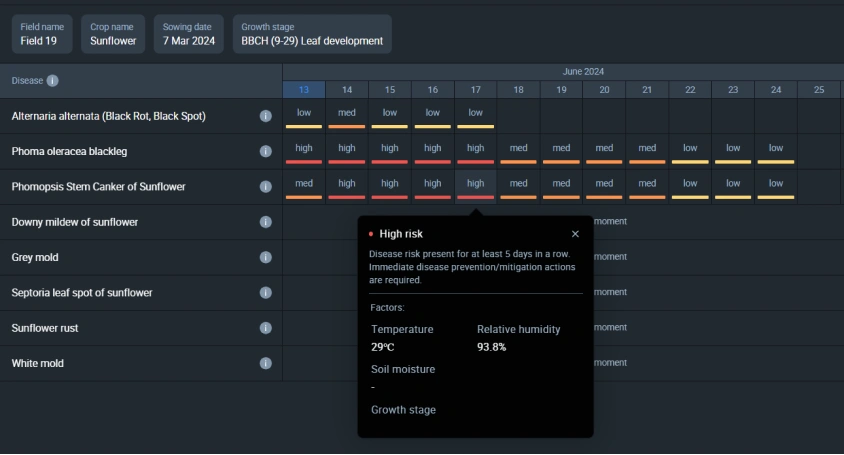
Pest Control
Insects that grow and feed on the crop can be broken down into seasonal groups according to the degree of danger they pose.
| Stage | Pests |
|---|---|
| Seedling | Wireworms, cutworms, beetles |
| Vegetative | Sunflower beetles, thistle (painted lady) caterpillars, stem weevils |
| Flowering Seed development | Maggots, weevils, midges, lygus bugs, moths |
Along with that, aphids might be a concern during the whole sunflower cultivation season. Integrated pest management methods are the best option for pest control, given the growing concerns about the environmental footprint. Among these methods, crop rotation stands out due to its ability to interrupt insect, weed, and disease cycles.
For the best results, grow both warm- and cool-season broadleafs and grasses in a crop rotation. By strategically rotating crops, you can reduce the number of pests that overwinter in your fields. To reduce the possibility of white mold propagation, sunflowers can be rotated with sclerotinia-resistant crops within a cycle of at least four years. As an additional benefit, compared to yields from growing sunflowers in a monoculture, yields from this crop grown in a rotation with potatoes, beans, sugar beets, and wheat are significantly greater.
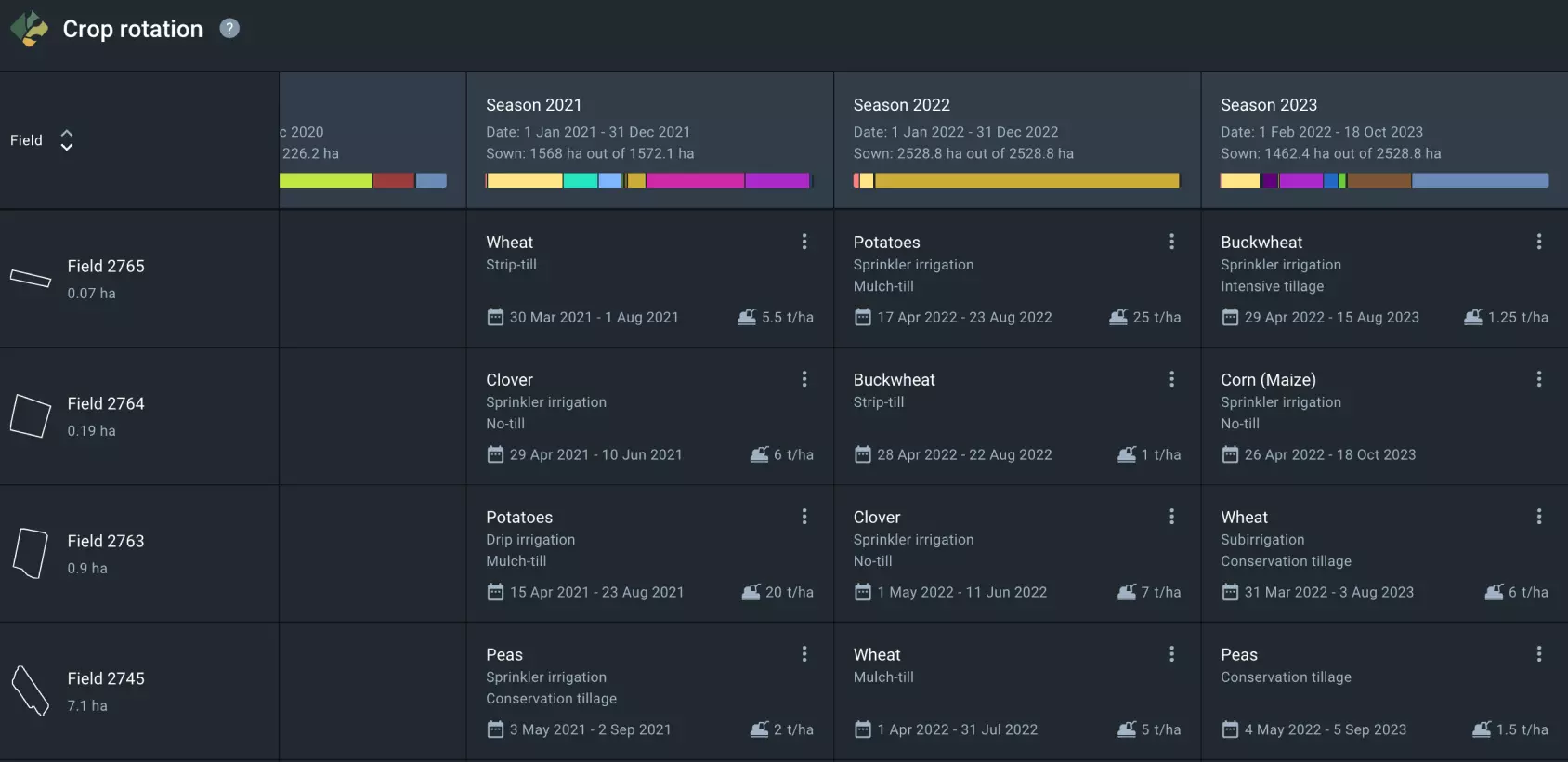
How To Harvest And Handle Sunflower Seeds
The timing and techniques of harvesting sunflower seeds have a significant impact on the quality and quantity of yields. Desiccating the plants allows for a quicker harvest and, thus, a faster time to market. Desiccants should be applied when the plants are physiologically mature, as shown by the head’s backside turning yellow, the bracts becoming yellow or brown, and the seed moisture content dropping to about 35%.
When To Harvest
It might be difficult to time the harvest of seeds. Too early of a harvest could result in immature seeds, while waiting too long may result in birds eating them. The best time to harvest sunflowers is when their petals start to dry and drop to the ground. If you plan on cutting the stem before drying the seeds, wait until the flower’s back becomes yellow, and if you want to keep the stem intact, wait until the back turns brown.
The NDRE index should be used now to prevent unnecessary yield loss. When plants are fully grown and ready for harvest, NDVI (measuring the degree of the canopy’s greenness) is not as reliable a gauge of crop health as NDRE (measuring chlorophyll levels). Knowing whether or not your mature plants will need additional care during the sunflower harvesting time can be a huge help when planning field operations.
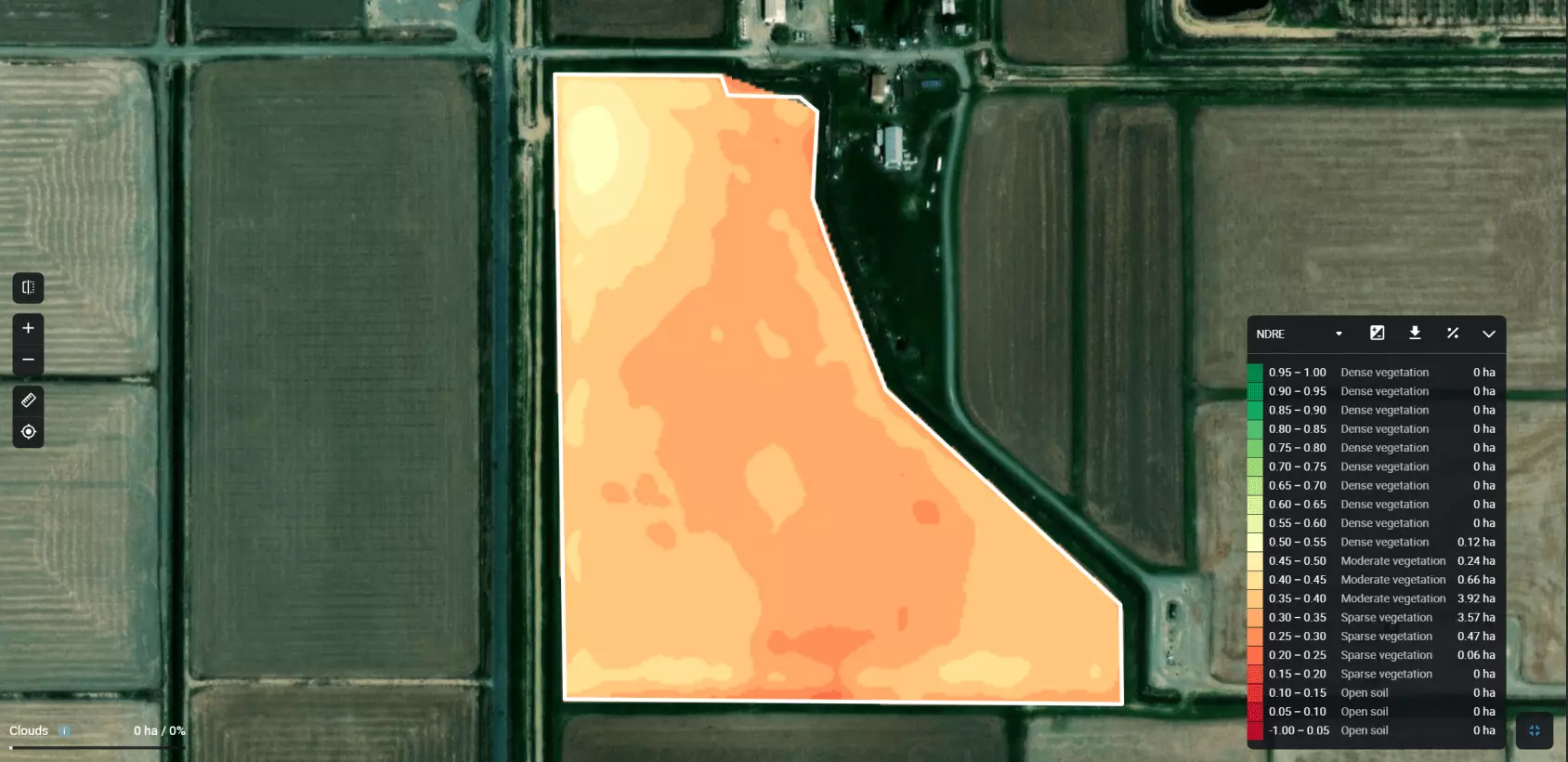
While getting ready for the sunflower harvesting season and beyond, you can rely on the crop yield prediction methodology developed by the EOSDA. It helps agriculture producers save time and money by making well-informed harvesting decisions, reducing production risks, and better preparing for the future of the market.
How To Harvest Sunflower Seeds
Because of its efficiency, speed, and reduced need for human labor, mechanized harvesting of sunflowers has become the primary method in modern large-scale growing. Both specialized combine harvesters and, more economically, a sunflower combine header attached to a standard combine harvester are used for this task. The combine’s stalk lifters pick up the headers, snip them off with a cutting device, and deposit them for threshing.
Using row-less combine headers has proven to be the most efficient method in recent years. They may accommodate different row configurations, such as solid or in-line, and pick plants in any area, including as tricky as the field’s edge or an irregularly shaped plot.
What To Do With Sunflower Seeds After Harvest
The seeds are kept well if they are dried and cooled. Before storing seeds, lower their temperature to less than 68°F (20°C). Limiting the storage temperature between 50 and 64°F (10 and 18°C) will prevent pests and mold from growing. The ideal humidity range for storing them is between 7.5% and 9.5% (the higher the seed oil content, the lower the humidity).
Small-grain bins are suitable for storing the seeds. Keeping seeds in polybags is growing in popularity, particularly when there isn’t enough capacity in bins. To ensure the quality of sunflower seeds after harvesting, inspect and sample them at least every 15 days.
Growing sunflowers for profit requires careful planning, constant monitoring, and resilience to adversity. Despite its low maintenance costs and high output potential, sustainable growing requires competence in soil management, disease and pest control, and field operations timing. If these factors align, growing sunflowers may bring tremendous agricultural and economic benefits.
About the author:
Vasyl Cherlinka is a Doctor of Biosciences specializing in pedology (soil science), with 30 years of experience in the field. He attended the engineering college in Ukraine and received his degree in agrochemistry, agronomy and soil science in the Chernivtsi National University. Since 2018, Dr. Cherlinka has been advising EOSDA on problems in soil science, agronomy, and agrochemistry.
Recent articles
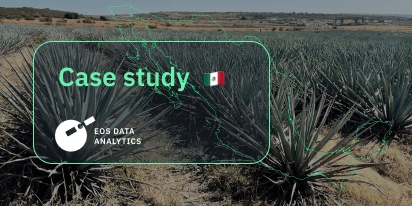
Digital Tools Improve Soil Health And Yields In Mexico
EOSDA and ITTA supported a Guanajuato farm with contour-line planning, monitoring tools, and practical guidance to reduce soil erosion and improve yields in the long run.

Analyze 2025 & Plan Your Best Year Yet: LandViewer Christmas Offer
It’s the most wonderful time of the year! The Christmas holidays are here, and so is your chance to analyze 2025 and plan a prosperous 2026 with more affordable Pro plans in LandViewer.

EOSDA Models Climate Change Impact On Sugarcane Yields
EOSDA modeled future temperature, rainfall, and other climate impacts on Veracruz sugarcane. The results help growers plan long-term adaptation strategies, including timing, varieties, and irrigation.